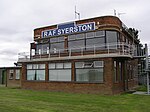Battle of Stoke Field

The Battle of Stoke Field on 16 June 1487 may be considered the last battle of the Wars of the Roses, since it was the last major engagement between contenders for the throne whose claims derived from descent from the houses of Lancaster and York respectively. The Battle of Bosworth Field, two years previously, had established King Henry VII on the throne, ending the last period of Yorkist rule and initiating that of the Tudors. The Battle of Stoke Field was the decisive engagement in an attempt by leading Yorkists to unseat him in favour of the pretender Lambert Simnel. Though it is often portrayed as almost a footnote to the major battles between York and Lancaster, it may have been slightly larger than Bosworth, with much heavier casualties, possibly because of the terrain which forced the two sides into close, attritional combat. In the end, though, Henry's victory was crushing. Almost all the leading Yorkists were killed in the battle.
Excerpt from the Wikipedia article Battle of Stoke Field (License: CC BY-SA 3.0, Authors, Images).Battle of Stoke Field
Humber Lane, Newark and Sherwood
Geographical coordinates (GPS) Address Nearby Places Show on map
Geographical coordinates (GPS)
| Latitude | Longitude |
|---|---|
| N 53.035 ° | E -0.888 ° |
Address
Battle of Stoke Field 1487
Humber Lane
NG23 5QG Newark and Sherwood
England, United Kingdom
Open on Google Maps








